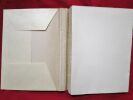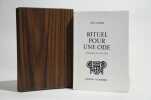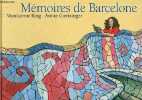116 books for « roig a »Edit
-
Type
Book (113)
Music sheets (3)
-
Language
French (115)
Spanish (1)
-
Century
16th (1)
19th (2)
20th (56)
21st (18)
-
Countries
Belgium (9)
Côte d'Ivoire (1)
Denmark (1)
France (94)
Greece (1)
Switzerland (10)
-
Syndicate
CLAM (2)
ILAB (55)
NVVA (3)
SLACES (3)
SLAM (48)
Topics
- Ampelography - wines (1)
- Amsterdam (1)
- Antibiotics (1)
- Architecture (1)
- Barcelona (1)
- Bible (1)
- Biography (1)
- Carnival (1)
- Cartography (1)
- Catalonia (1)
- Cendrars blaise (1)
- Churches (1)
- Cooking (1)
- Cuba (1)
- Culinary art (1)
- Curiosa (1)
- Customs (1)
- Customs (1)
- Dali (1)
- Dali pc (1)
- Dictionaries (2)
- Drawings (1)
- Drink (2)
- Economics (1)
- Education (1)
- Fine arts (1)
- First edition (2)
- Fishing (2)
- Fishing hunting (2)
- Gastronomy (1)
- Gastronomy food (3)
- History (3)
- Home economics (3)
- Humanitarian sciences (1)
- Illustrated books (1)
- Law (2)
- Lénine (1)
- Literature (12)
- Louys pierre (1)
- Magazine (3)
- Manuscripts (1)
- Mathematics (1)
- Medicine (1)
- Nazism (1)
- Newspapers press (3)
- Nutrition (3)
- Optics (2)
- Painting (1)
- Painting (1)
- Philosophy (1)
- Pibrac (1)
- Poetry (2)
- Policy (2)
- Portugal (3)
- Professions guilds (1)
- Psychology (1)
- Raphael (1)
- Regionalism (3)
- Reviews (3)
- Roig montserrat (6)
- Rome (1)
- Rops félicien (1)
- Scores (4)
- Songs (3)
- Spain (4)
- Spanish (1)
- Spanish war (1)
- Topography (1)
- Ussr (1)
- Various (1)
- Version (1)
- War (1)
Libre de consells. - [""SCARCELY ANY SPANISH BOOK IS MORE RARE THAN THIS FIRST EDITION OF ROIG""]
Valencia, Francisco Diaz Romano, 1531. 4to (205 x 145 mm). Exquisitely bound in a sumptuous richly blind-ornamented and gilt 20th century full calf binding. Five raised bands, gilt lettering, and smaller gilt decorations to richly blindstamped spine. Boards elaborately blindstamped with frames in different patterns and with smaller dispersed gilt ornamentations. Front board with a large centre-piece, also elaborately blindstamed and with gilt ornamentations, at the center of which the words “Libre de Consells de Jaume Roig” in gilt Gothic lettering. Back board with the same large centre-piece repeated, inside which a gilt centre-illustration (reminiscent of Bacchus) and the words “a bon seny no hi valengan” (Old Catalan for “common sense is not worth it”) in gilt lettering underneath. Binding signed Miquerlius to lower inside of front board. Single gilt line to edges of boards and broad inner gilt dentelles. All edges gilt. Leaf A4 with ink-annotations in contemporary hand. First leaves with marginal repairs and a closed wormtract, with loss of a few letters. Leaves L-O with closed wormtract in upper outer margin. Last leaves with marginal repairs and final leaf (woodcut illustration) with closed tear and a few wormholes, with minor loss of the illustration. With occasional brownspotting and a few leaves evenly browned. Washed. 139, (1) pp. (A-R8, S4)
The exceedingly rare first edition of Roig’s magnum opus, his seminal masterpiece of Catalan literature. This satirical work on women offering extensive advice on avoiding their alleged deceptive nature, the pitfalls of marriage, including all the misadventures Roig himself has suffered during four marriages is widely considered one of the most significant pieces of literature in Catalan. The first edition is of the utmost scarcity and hardly ever finds its way into the trade. Salva (author of “Catalogue of Spanish and Portuguese Books with occasional literary and bibliographical remarks”) only knew of two complete copies, and as early as 1735, the book was already so unprocurable that the editor of an attempted reprint had to omit some parts for lack of an early copy. Salva’s own copy is now housed in the British Library, who states: “Scarcely any Spanish book is more rare than this first edition of Roig, of which Carlos Ros, who edited the works of Roig in 1735, was unable to find any copy whatever. It was unknown to Nic. Antonio who quotes the second edition of 1532 as if it was the first”. It was written in 1459-60 and has only survived in one manuscript (MS. Vat. Lat. 4806). During the sixteenth century, however, several editions of Roig’s text were published, although with a modified title: Llibre de consells (Valencia, 1531 and 1532" Barcelona, 1561) and Llibre de les dones me´sverament dit de consells (Valencia, 1561)" in recent years, it is often seen referred to as “The Espill” or ""The Mirror"". While the 15th century saw the emergence of other renowned literary works in Catalan, such as Tirant lo Blanc by Joanot Martorell and the anonymously written Curial e Güelfa, the present work distinguishes itself through its distinctive fusion of realism, social critique, sharp satire and, to some extent, medical knowledge. This combination makes it a remarkable portrayal of the evolving socioeconomic dynamics and cultural attitudes of Valencian society at the time: “(The present work) is mere fiction, but it is full of autobiographical elements and, despite the deformations imposed by the literary genre, it especially offers a very realistic picture of Valencian society in the 15th century and specifically of the city of Valencia. Roig describes very precise aspects of the trades and customs of the era and evokes real events which he knew about first-hand. He also furnishes priceless details on the knowledge and profession of medicine. In any event, as Antònia Carré accurately states, “the satirical deformations and comical inversions of Espill should be understood within the context of Galenic medicine.” (Ferrando, Catalan fiction in the 15th century, p. 37) ”The Espill (1460) (also called Libre de consells (Book of Advice) or Libre de les dones (Book of the Women) by its old publishers) seems to me to be one of the most singular works in 15th-century Valencian art as a consequence of the summa of a series of elements that its author, Jaume Roig (circa 1400-1478), mixes with unusual skill. Thus, its format (a narrative poem that consists of over sixteen thousand tetrasyllabic couplets), its subject matter (a misogynist satire with didactic and moralising contents), its external (a preface and four books divided into four sections) and internal (resort to fictitious autobiography in three of the four books) structures, the medieval traditions that channel the discourse (artes praedicandi, exempla, jokes...), the linguistic and rhetorical registers used (combining colloquial and vulgar language with learned terms), etc. However, Roig’s singularity must be understood equally in the literary context of 15th century Valencia, as interesting interrelations can be established between its creation and some of the most important works and authors of that time, ranging from Joanot Martorell to Joan Roís de Corella, passing through Isabel de Villena. On the other hand, it is also worth highlighting its wider context, for example in relation with its dialogue with the classical and biblical traditions or with the European (and Hispanic) “pro-” and “anti-feminist” debates of the 13th century, as Cantavella has analysed, within which it consolidates scientific and religious references, which are what are of most interest here” (Merida, Sodomy and the Sick Body of Women).In the 15th century, Catalan fiction flourished within the context of the Crown of Aragon's Mediterranean expansion marked by the rise of Valencia as its cultural center, a growing monetary economy, and increased interaction with other European regions, notably Italy, France and Burgundy. This rich environment produced several significant literary works including the present.“In the second half of the 15th century, writers from or imitating the bourgeoisie who liked to cultivate satirical and burlesque stories in verse, often in collaboration with one another, proliferated in Valencia. One of the most prominent was Jaume Roig... His Espill, is much more than a simple misogynistic satire: it is a true novel that quite skilfully describes the most grotesque aspects of the society of his day. (Ferrando, Catalan fiction on the 15th century, p. 37). Although bitter towards women in general, the work culminates in a glorification of the Virgin and finally in a beautiful full-page woodcut of the Virgin and Child with Saints Dorothy and Eulalie and two other saints - considered a masterpiece of the late Spanish Gothic style. Jaume Roig (circa 1400 – 1478) was a Valencian doctor and medical advisor to Dona Maria, wife of Alfonso V. “He studied Medicine and Arts and soon became a prominent doctor in the city, where he combined his medical practice with reading and writing. In 1443 he married Isabel Pellisser with whom he had six children. Jaume Roig's Espill was one of the most important works of the fifteenth century. His writing was in the romantic tradition of narrative in verse, not to mention the misogynist didactic tradition with comic and instructive elements. Espill consists of 16,359 couplets by means of which the narrator addresses his nephew, warning him about the ill-treatment he has received from women and therefore advising him to keep away from the female sex. Divided into an introductory poem, a Preface and four ""books"", Espill had a great impact in its day, so much so that four editions were published in the sixteenth century.” (Associació d'Escriptors en Llengua Catalana). Palau 275503: ""rarissima"" Lyell, p. 118: ""very rare"" Brunet IV, 1356: ""fort rare""
LOUYS, Pierre (ou Chrysis ou Peter Lewys ou Pibrac) - P. ROÏG - RIOM.
Reference : 108027
La Femme et le Pantin. Roman Espagnol. Illustrations de P. ROÏG, Décoration de RIOM.
Paris, L'Edition d'Art, H. Piazza & Cie, 4 rue Jacob, 1903, 1 volume in-8 de 235x165x30 mm environ, 1f.blanc, 229 pages, 1f. (justificatif de tirage, achevé d'imprimer), 1f.blanc, sous chemise rempliée illustrée et chemise à rabats cartonnée couleur bronze portant titres dorés, orné d'un médaillon sur le premier plat et sur le dernier plat, feuillets non rognés. Exemplaire N°75, un des 260 exemplaires sur papier vélin à la cuve des manufactures Blanchet et Kléber, numérotés de 41 à 300, complet des 50 compositions en couleurs de P. ROÏG, dont 17 HT. Magnifiques encadrements floraux (certains en couleurs) dans le style Art Nouveau. Chemise abimée et fragile, ouvrage à relier, sinon pages en très bon état.
Pierre Félix Louis, dit Pierre Louÿs, est un poète et romancier français, né à Gand (Belgique) le 10 décembre 1870 et mort à Paris 16e le 4 juin 1925.Il est également connu sous les noms de plume Chrysis, Peter Lewys et Pibrac. Merci de nous contacter à l'avance si vous souhaitez consulter une référence au sein de notre librairie.
Rituel pour une Ode, avec des illustrations de FILLOL ROIG.
Caractères, 1978. In-8, 141 pp., étui.
Édition originale, un des 30 sur vélin d'Arches, enrichi de quatre jolies GOUACHES ORIGINALES SIGNÉES et numérotées par Vincent Fillol Roig. Long ENVOI à Pascal Mazotti au faux-titre, à « l'acteur comme à l'homme d'esprit et de cur ». Joint une carte de vux de Roig, 1964, ornée d'une petite gouache originale. * Voir photographie(s) / See picture(s). Fermeture pour congés, TRAITEMENT DES COMMANDES SUPSENDU JUSQU'AU 29 DECEMBRE. * Membre du SLAM et de la LILA / ILAB Member. La librairie est ouverte du lundi au vendredi de 14h à 19h. Merci de nous prévenir avant de passer,certains de nos livres étant entreposés dans une réserve.
[ Harcourt] - Lasso Gloria - Roig Gonzalo - Chamfleury Robert,Roig Gonzalo
Reference : 100984
Partition de la chanson : Sourire (Un) ( Quiereme mucho )
Garzon
Très bon état Petit format
Partition de la chanson : Quiereme mucho Baiser tendre (Un) Chanson Créole
Garzon 1930 approx.
Etat moyen Petit format
Los Espagnoles pintados por si mismos. Por varios autores. ‘Biblioteca ilustrada de Gaspar y Roig’.
Madrid, Gaspar y Roig, 1851, gr. in-8vo, 243 p., illustr. con 100 grabados, clothbound, spine sunshadet.

(SLACES, NVVA)
Phone number : 41 (0)26 3223808
Cours de Physique générale : RECUEIL de PROBLEMES. 4e édition revue et complétée par J. Roig.
1954 Paris, Masson, 1956, grand in 8° relié pleine toile de l'éditeur, XII-521 pages.
...................... Photos sur demande ..........................


Phone number : 04 77 32 63 69
La femme et le pantin
L'édition d'art | Paris 1903 | 16 x 22.20 cm | relié sous étui
Nouvelle édition illustrée imprimée à 300 exemplaires numérotés, le nôtre sur papier Vélin à la cuve. Ouvrage ornéde 50 dessins en couleur de Pablo Roïg et décoré d'encadrements de style Art Nouveau par Riom. Reliure en plein chagrin marron, dos passé à cinq nerfs intégralement estampé à froid de suites de demi-cercle orné d'illets dorés, filets à froid soulignant les nerfs, date et lieu d'édition en queue, plats en encadrement intégralement estampés d'un quadrillage de filets à froid formant des compartiments ornés en leur centre d'un illet doré, grande plaque réalisée par Saint-Andréau centre du premier platciselé en creuxd'un motif andalou représentant "des rinceaux d'or enserrant un fantôme d'arbre... comme, dans le roman, de P. Louys, la femme enserre un fantôme d'homme" dans un double encadrement doré, signature de l'artiste à l'extérieur de la plaque, roulettes dorées soulignant les coupes et les coiffes, contreplats et gardes de soie peinte aux motifs de roses par le même Saint-André, filets et roulette dorés et motifs à froid incisé de maroquin émeuraude et grenat en encadrement des contreplats, gardes doublées de papier à motifs floraux gris et oranges, couvertures conservées, toutes tranches dorées.Etuirecouvert d'un tissu de soie à effet moirébordé de chagrinbrun. Reliure signée de Noulhac en collaboration avec Saint-André. Note manuscrite de Saint-André, cette reliure fut probablement présentée au Salon des artistes français au Grand Palais des Beaux-Arts aux Champs-Elysées inscrit en hors concours et membre du jury. En outre, un mot manuscrit de la main de l'artiste sur feuillet volant explique le sens du motif central du premier plat. Très discrète restauration en pied d'un mors. Exceptionnelle reliure Art Nouveaud'inspiration andalouse présentée auSalon des artistes français. - Photographies et détails sur www.Edition-Originale.com -


Phone number : 01 56 08 08 85
Mémoires de Barcelone.
La Sirène. 1993. In-8. Relié. Bon état, Couv. convenable, Dos satisfaisant, Intérieur frais. 76 pages - nombreux dessins en couleurs dans le texte.. . . A l'italienne. Classification Dewey : 860-Littératures espagnole et portugaise
Les textes de Montserrat Roig ont été traduits du catalan par Victor Mora. Classification Dewey : 860-Littératures espagnole et portugaise
Miguel (Ramon) - Roig Jaume - Costa Marie-Noëlle [Collection catalane N° 12]
Reference : 13705
ISBN : 2878024370
Espil / Miroir. Llibre de consells ou livre de conseils. Llibre de les Dones ou livre des Femmes.
Poème Valencien de 1460 en version Intégrale bilingue, traduit en pentasyllabes français non rimés par Marie Noëlle Costa à partir du manuscrit N° 4806 de la Bibliothèque Vaticane, transcrit par Ramon Miguel i Planas (1950 ) La Tour de Gile - Collection catalane N° 12 - 2008 - In-8°, broché, fort volume de 492 pages , bel et bon exemplaire.
Bon Etat Franco de port France jusqu'à 29 euros iclus. MONDIAL RELAY pour : FRANCE, Portugal, Pologne, Espagne, Allemagne, Autriche, Pays Bas, Luxembourg, Italie, Belgique. Toutes les étapes sont accompagnées. Achat, estimations et listages France / Suisse (sur rdv).
Lautaro Roig Lanzillotta, Jos Lu s Brand o, Cl udia Teixeira, lia Rodrigues (eds)
Reference : 64450
Roman Identity. Between Ideal and Performance
, Brepols, 2023 Paperback, 402 pages, Size:156 x 234 mm, Illustrations:10 col., 2 tables b/w., Language: English. ISBN 9782503599229.
Summary Recent years have seen a significant increase in migration and displacement. Due to economic, political, and climatic pressures, large numbers of individuals are leaving their countries of origin and settling in new environments and societies. As a result, national identity has increasingly come to the fore in public discourse. Shaping and reshaping national agendas, debates surrounding national identity are affecting policies and influencing voting behaviours. Discourse on this issue is often centred on the idea of autochthony and nativism. Yet we do not encounter such anxieties in ancient Rome, one of the longest-lasting political orders in history. Unlike among the Greeks, the idea of autochthony did not take root among the Romans. Instead, Rome's identity tended to be fluid, accommodating the development of highly variegated and multi-ethnic groups and societies. The purpose of this volume is to understand how the Romans represented themselves and how others defined and regarded them. It aims to identify the various narratives that contributed to the construction of Roman self-representation by raising the following questions: What stories did Romans tell about themselves? How did they enact and perform their selfhood in biographical and autobiographical sources? How did Greek and Judean sources understand and define Roman identity? And, taken together, how did these narratives influence Roman self-perception? Rather than arguing for a monolithic or coherent understanding of Romanitas, this volume explores a variety of performances and manifestations of Roman identity. It focuses both on sources where the self or individual is the primary focus, alongside more general texts dealing with specific elements of Roman identity. TABLE OF CONTENTS Introduction: Defining Self and Other in Changing Situations and Discourses. The Dynamism and Fluidity of the Notion of Identity (Lautaro Roig Lanzillotta) I. Roman Identity in (Auto)Biographical Texts Similarities and Dissimilarities: Roman Identity and Models of Behaviour in Nepos' Punic Lives (Francesco Ginelli) Identity in Latin Verse Autobiography (Helen Kaufmann) Lucretia, Tullia and Tanaquil: Shaping the Identity of Rome's Women in the Augustan Period (Nuno Sim es Rodrigues) Pythagoreanism and Roman Identity in Plutarch's Aemilius Paullus (Davide Morelli) Overcoming Otherness in Flavian Rome: Flavius Josephus and the Rhetoric of Identity in the Bellum Judaicum (Eelco Glas) Performing Roman Identity in Suetonius' Caesars (Jos Lu s Brand o) When the Emperor is the Other: Perceptions of Identity in the Historia Augusta's Life of Maximinus (Cl udia Teixeira) II. Roman Identity in Political and Legal Discourses Quirites and Populus Romanus: New Identities and Old Figures in Archaic Legal Formulas (Carlo Pelloso) Rome in the Mirror: Varro's Quest for the Past, for a Present Goal (Federica Lazzerini) Sacra privata perpetua manento: A Reading of Cicero's De Legibus (Cl udia Beltr o) Roman Maiestas: Becoming Imperial, Staying Republican ( lia Rodrigues) What's in a Natio: Negotiating Ethnic Identity in the Roman Empire (Kelly Nguyen) Index rerum ac nominum
Rops...iana
Paris 1924 Editions Pellet Soft cover
Rops...iana Broché, couverture illustrée, 270 x 210 mm, 173 pp, édition originale illustrée d'un portrait de Jean de Roig d'après Louis Legrand gravure et impression en taille-douce de V. Jacquemin avec 20 illustrations hors texte cet ouvrage a été tiré a 500 ex. sur vergé d'arches teinté , ceci est le nr 295 les pages coupées inégale très bon état

(CLAM, )
Phone number : +32(0)496 80 81 92
Rops...iana.
Pars, Éditions Pellet, 1924. 26,5 x 20,5 cm, xi-174 pp. Broché, couverture illustrée. Exemplaire en bon état. Édition originale illustrée d'un portrait de Jean de Roig d'après Louis Legrand et de 20 hélios hors texte dont 1 rehaussée au pochoir (Après le baptême). Tirage unique à 500 exemplaires sur vergé d'Arches teinté.
Études sur le Parlement de la Ve République : Par Éliane Guichard-Ayoub Charles Roig et Jean Grangé
Presses universitaires de France Vendôme Impr. des P.U.F 1965 295 pages 1965. 295 pages.
ESPARDENYA. ROMAN.
Amsterdam, Wereldbibliotheek, 1988 Paperback, originele uitgeversomslag geillustreerd door Joost van de Woestijne, 21x12.9 cm., 130 pp. + 1. ISBN 9028415467.
Deze Catalaanse roman speelt zich af in het Barcelona van na de Spaanse Burgeroorlog.
Les Catalans dans les camps nazis.
Triangle Bleu - Documentation et Archives des Républicains espagnols déportés de France & Génériques, 2005. Fort volume in-8 br. de 732 pages. Coll. " Documents pour l'histoire ". Préface de S. Bouziri et autres textes de présentation. Préambule d'Artur London pour l'édition catalane de 1977. Photographies hors-texte, bibliographie, fiches des déportés, etc. E.O.
Rituel pour une Ode
Paris, 1978, in-8, 140pp, broché, Très bel exemplaire illustré par Roig! 140pp
Dictionnaire des Polluants Alimentaires.
CEVIP In-8°,broché,couverture verte,389 pages, bon ensemble complet de ses annexes.
Bon Etat Franco de port France jusqu'à 29 euros iclus. MONDIAL RELAY pour : FRANCE, Portugal, Pologne, Espagne, Allemagne, Autriche, Pays Bas, Luxembourg, Italie, Belgique. Toutes les étapes sont accompagnées. Achat, estimations et listages France / Suisse (sur rdv).
Le temps des cerises
Delcourt Littérature (5/2024)
LIVRE A L’ETAT DE NEUF. EXPEDIE SOUS 3 JOURS OUVRES. NUMERO DE SUIVI COMMUNIQUE AVANT ENVOI, EMBALLAGE RENFORCE. EAN:9782413085089
Cours complet de peinture
Larousse pratique (10/2022)
LIVRE A L’ETAT DE NEUF. EXPEDIE SOUS 3 JOURS OUVRES. NUMERO DE SUIVI COMMUNIQUE AVANT ENVOI, EMBALLAGE RENFORCE. EAN:9782295014672
ENVERS DU MONDE -L'-
HORS D'ATTEINTE EDITIONS
LIVRE A L’ETAT DE NEUF. EXPEDIE SOUS 3 JOURS OUVRES. NUMERO DE SUIVI COMMUNIQUE AVANT ENVOI, EMBALLAGE RENFORCE. EAN:9782382572375
L'heure violette
Delcourt Littérature (5/2025)
LIVRE A L’ETAT DE NEUF. EXPEDIE SOUS 3 JOURS OUVRES. NUMERO DE SUIVI COMMUNIQUE AVANT ENVOI, EMBALLAGE RENFORCE. EAN:9782413089407
La cuisine des lacs italiens
Hachette pratique (9/2024)
LIVRE A L’ETAT DE NEUF. EXPEDIE SOUS 3 JOURS OUVRES. NUMERO DE SUIVI COMMUNIQUE AVANT ENVOI, EMBALLAGE RENFORCE. EAN:9782017252993
Provence : food trip ensoleillé en 100 recettes
Hachette pratique (11/2020)
LIVRE A L’ETAT DE NEUF. EXPEDIE SOUS 3 JOURS OUVRES. NUMERO DE SUIVI COMMUNIQUE AVANT ENVOI, EMBALLAGE RENFORCE. EAN:9782019453527
ÉTUDES SUR LE PARLEMENT DE LA Ve RÉPUBLIQUE, Préface de Marcel Prélot, coll. Travaux et recherches de la faculté de droit et des Sciences Économiques de Paris, série “science politique” n°2
, Paris, P.U.F. 1965, in-8, br., bon état, VIII-294p.


Phone number : 01 43 29 46 77
 Write to the booksellers
Write to the booksellers














